Bosch 1660, 1662 User Manual
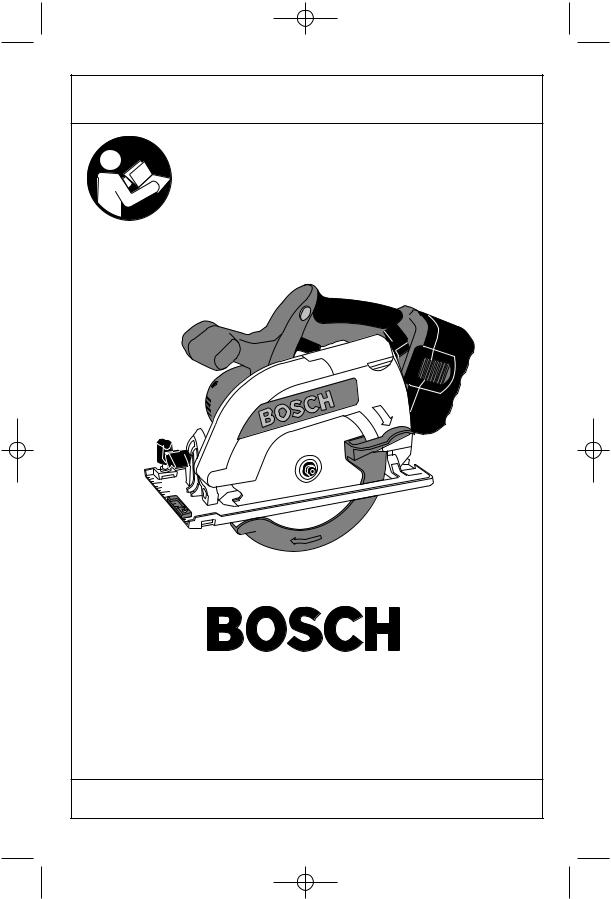
BM |
2610914527 3/03 |
3/18/03 |
10:47 AM |
Page 1 |
|
|
IMPORTANT: |
IMPORTANT : |
IMPORTANTE: |
||
|
Read Before Using |
Lire avant usage |
Leer antes de usar |
||
|
|
Operating/Safety Instructions |
|||
|
|
Consignes de fonctionnement/sécurité |
|||
|
|
Instrucciones de funcionamiento |
|||
|
|
y seguridad |
|
|
|
|
1660 |
|
|
|
|
|
1662 |
|
|
|
|
|
|
|
Consumer Information |
||
|
|
Renseignement des consommateurs |
|||
|
|
Información para el consumidor |
|||
|
Toll Free Number: |
Appel gratuit : |
Número de teléfono gratuito: |
||
|
1-877-BOSCH99 (1-877-267-2499) http://www.boschtools.com |
||||
|
For English |
|
Parlez-vous français? |
¿Habla español? |
|
|
See page 2 |
|
Voir page 16 |
Ver página 30 |
|

BM 2610914527 3/03 3/18/03 10:47 AM Page 2
|
|
General Safety Rules |
|
|
For All Battery Operated Tools |
|
|
|
|
|
Read and understand all instructions. Failure to follow all instructions listed |
|
! WARNING |
|
|
below, may result in electric shock, fire and/or serious personal injury. |
|
|
|
|
|
|
SAVE THESE INSTRUCTIONS |
Work Area
Keep your work area clean and well lit.
Cluttered benches and dark areas invite accidents.
Do not operate power tools in explosive atmospheres, such as in the presence of flammable liquids, gases, or dust. Power tools create sparks which may ignite the dust or fumes.
Keep by-standers, children, and visitors away while operating a power tool.
Distractions can cause you to lose control.
Electrical Safety
Do not abuse the cord. Never use the cord to carry the tool. Keep cord away from heat, oil, sharp edges, or moving parts. Replace damaged cords immediately. Damaged cords may create a fire.
A battery operated tool with integral batteries or a separate battery pack must be recharged only with the specified charger for the battery. A charger that may be suitable for one type of battery may create a risk of fire when used with another battery.
Use battery operated tool only with specifically designated battery pack. Use of any other batteries may create a risk of fire.
Personal Safety
Stay alert, watch what you are doing, and use common sense when operating a power tool. Do not use tool while tired or under the influence of drugs, alcohol, or medication. A moment of inattention while operating power tools may result in serious personal injury.
Dress properly. Do not wear loose clothing or jewelry. Contain long hair. Keep your hair, clothing, and gloves away from moving parts. Loose clothes, jewelry, or long hair can be caught in moving parts.
Avoid accidental starting. Be sure switch is in the locked or off position before inserting battery pack. Carrying tools with your finger on the switch or inserting the battery pack into a tool with the switch on invites accidents.
Remove adjusting keys or wrenches before turning the tool on. A wrench or a key that is left attached to a rotating part of the tool may result in personal injury.
Do not overreach. Keep proper footing and balance at all times. Proper footing and balance enable better control of the tool in unexpected situations.
Use safety equipment. Always wear eye protection. Dust mask, non-skid safety shoes, hard hat, or hearing protection must be used for appropriate conditions.
Tool Use and Care
Use clamps or other practical way to secure and support the workpiece to a stable platform. Holding the work by hand or against your body is unstable and may lead to loss of control.
Do not force tool. Use the correct tool for your application. The correct tool will do the job better and safer at the rate for which it is designed.
Do not use tool if switch does not turn it on or off. A tool that cannot be controlled with the switch is dangerous and must be repaired.
Disconnect battery pack from tool or place the switch in the locked or off position before making any adjustments, changing accessories, or storing the tool.
Such preventive safety measures reduce the risk of starting the tool accidentally. Store idle tools out of reach of children and other untrained persons. Tools are dangerous in the hands of untrained users.
When battery pack is not in use, keep it away from other metal objects like: paper clips, coins, keys, nails, screws, or other
-2-
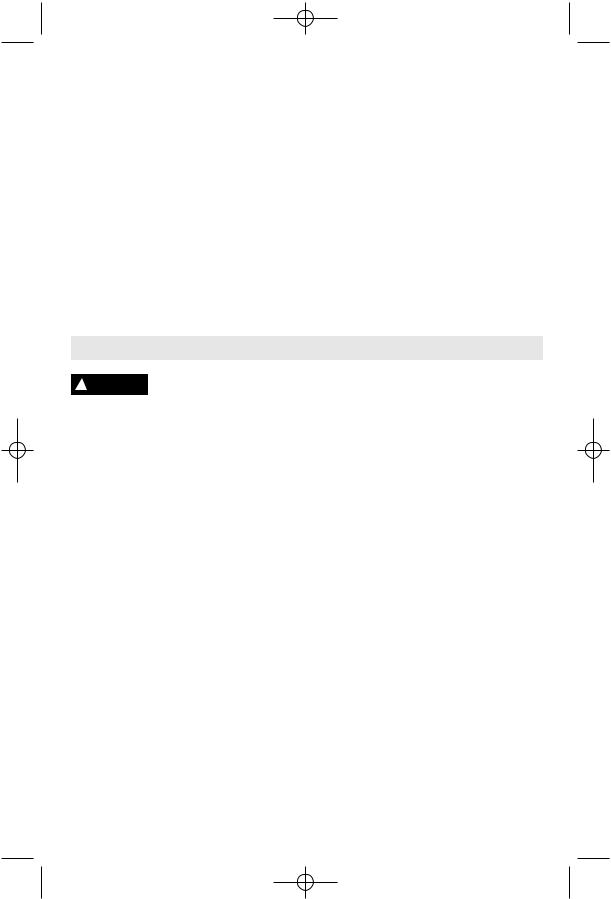
BM 2610914527 3/03 3/18/03 10:47 AM Page 3
small metal objects that can make a connection from one terminal to another.
Shorting the battery terminals together may cause sparks, burns, or a fire.
Maintain tools with care. Keep cutting tools sharp and clean. Properly maintained tools with sharp cutting edge are less likely to bind and are easier to control.
Check for misalignment or binding of moving parts, breakage of parts, and any other condition that may affect the tool's operation. If damaged, have the tool serviced before using. Many accidents are caused by poorly maintained tools.
Use only accessories that are recommended by the manufacturer for your
model. Accessories that may be suitable for one tool may create a risk of injury when used on another tool.
Service
Tool service must be performed only by qualified repair personnel. Service or maintenance performed by unqualified personnel may result in a risk of injury.
When servicing a tool, use only identical replacement parts. Follow instructions in the Maintenance section of this manual.
Use of unauthorized parts or failure to follow Maintenance Instructions may create a risk of shock or injury.
Safety Rules for Circular Saws
Keep hands away from cutting area and blade.
Keep your second hand on auxiliary handle, or motor housing. If both hands are holding the saw, they cannot be cut by the blade. Hold the saw firmly to prevent loss of control. Figures in this manual illustrate typical hand support of the saw. NEVER place your hand behind the saw blade since kickback could cause the saw to jump backwards over your hand.
Keep your body positioned to either side of the saw blade, but not in line with the saw blade. KICKBACK could cause the saw to jump backwards. (See “Causes and Operator Prevention of Kickback.”)
Do not reach underneath the work. The guard cannot protect you from the blade below the work. Do not attempt to remove cut material when blade is moving.
Check lower guard for proper closing before each use. Do not operate saw if lower guard does not move freely and close instantly. Never clamp or tie the lower guard into the open position. If saw is accidentally dropped, lower guard may be bent. Raise the lower guard only with the Lower Guard Lift Lever and make sure it moves freely and does not touch the blade or any other part, in all angles and depths of cut.
Check the operation of the lower guard spring. If the guard and the spring are not operating properly, they must be serviced
before use. Lower guard may operate sluggishly due to damaged parts, gummy deposits, or a buildup of debris. Disconnect battery pack from tool. Periodically remove the blade, clean the upper, lower guards and the hub area with kerosene and wipe it dry, or blow it clean with compressed air.
Lower guard should be retracted manually only for special cuts such as “Pocket Cuts” and “Compound Cuts”. Raise lower guard by Lower Guard Lift Lever. As soon as blade enters the material, lower guard must be released. For all other sawing, the lower guard should operate automatically.
Always observe that the lower guard is covering the blade before placing saw down on bench or floor. An unprotected, coasting blade will cause the saw to walk backwards, cutting whatever is in its path. Be aware of the time it takes for the blade to stop after switch is released.
NEVER hold piece being cut in your hands or across your leg. It is important to support the work properly to minimize body exposure, blade binding, or loss of control.
Hold tool by the insulated gripping surfaces when performing an operation where the cutting tool may contact hidden wiring or it own cord. Contact with a "live" wire will also make exposed metal parts of the tool “live” and shock the operator.
-3-
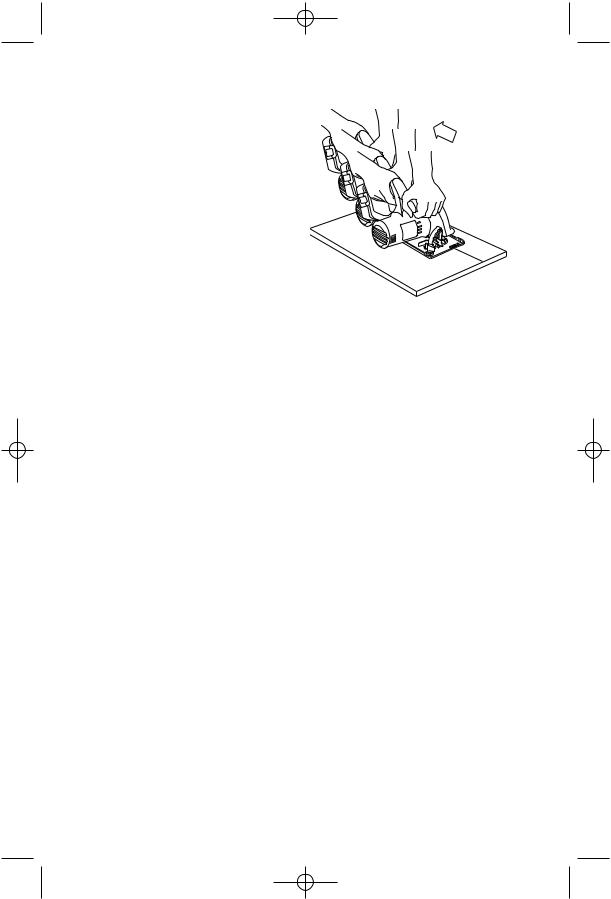
BM 2610914527 3/03 3/18/03 10:47 AM Page 4
When ripping always use a rip fence or straight edge guide. This improves accuracy of cut and reduces the chance for blade binding.
Always use blades with correct size and shape (diamond vs. round) arbor holes.
Blades that do not match the mounting hardware of the saw will run eccentrically, causing loss of control and will not allow proper vari-torque engagement.
Never use damaged or incorrect blade washers or bolts. The blade washers and bolt were specially designed for your saw, for optimum performance and safety of operation.
The blade washers and the bolt on your saw have been designed to work as a “VARITORQUE CLUTCH”. Understand the operation and settings of the VARI-TORQUE CLUTCH, because the proper setting of the CLUTCH, combined with firm handling of the saw will allow you to control KICKBACK.
Do not run the saw while carrying it at your side. Lower guard may be opened by a contact with your clothing. Accidental contact with the spinning saw blade could result in serious personal injury.
Depending upon use, the switch may not last the life of the saw. If the switch should fail in the “OFF” position, the saw may not start. If it should fail while the saw is running, the saw may not shut off. If either occurs, remove battery pack from saw immediately and do not use until repaired.
This circular saw should not be mounted to a table and converted to a table saw.
Circular saws are not designed or intended to be used as table saws.
CAUSES AND OPERATOR PREVENTION OF
KICKBACK:
Kickback is a sudden reaction to a pinched, bound or misaligned saw blade, causing an uncontrolled saw to lift up and out of the workpiece toward the operator.
When the blade is pinched or bound tightly by the kerf closing down, the blade stalls and the motor reaction drives the unit rapidly back toward the operator.
If the blade becomes twisted or misaligned in the cut, the teeth at the back edge of the blade can dig into the top surface of the wood causing the blade to climb out of the kerf and jump back toward the operator.
Kickback is the result of tool misuse and/or incorrect operating procedures or conditions
and can be avoided by taking proper precautions as given below:
KICKBACK
Maintain a firm grip with both hands on the saw and position your body and arm to allow you to resist KICKBACK forces.
KICKBACK forces can be controlled by the operator, if proper precautions are taken.
When blade is binding, or when interrupting a cut for any reason, release the trigger and hold the saw motionless in the material until the blade comes to a complete stop. Never attempt to remove the saw from the work or pull the saw backward while the blade is in motion or KICKBACK may occur. Investigate and take corrective action to eliminate the cause of blade binding. Wet lumber, green lumber or pressure treated lumber require special attention during cutting operation to prevent KICKBACK. Avoid cutting nails. Inspect for and remove all nails from lumber before cutting.
When restarting a saw in a workpiece, center the saw blade in the kerf and check that saw teeth are not engaged into the material. If saw blade is binding, it may walk up or KICKBACK from the workpiece as the saw is restarted.
Support large panels to minimize the risk of blade pinching and KICKBACK. Large panels tend to sag under their own weight. Supports must be placed under the panel on both sides, near the line of cut and near the edge of the panel. See “Cutting Large Sheets” in this manual.
Do not use dull or damaged blade.
Unsharpened or improperly set blades produce narrow kerf causing excessive friction, blade binding and KICKBACK.
-4-
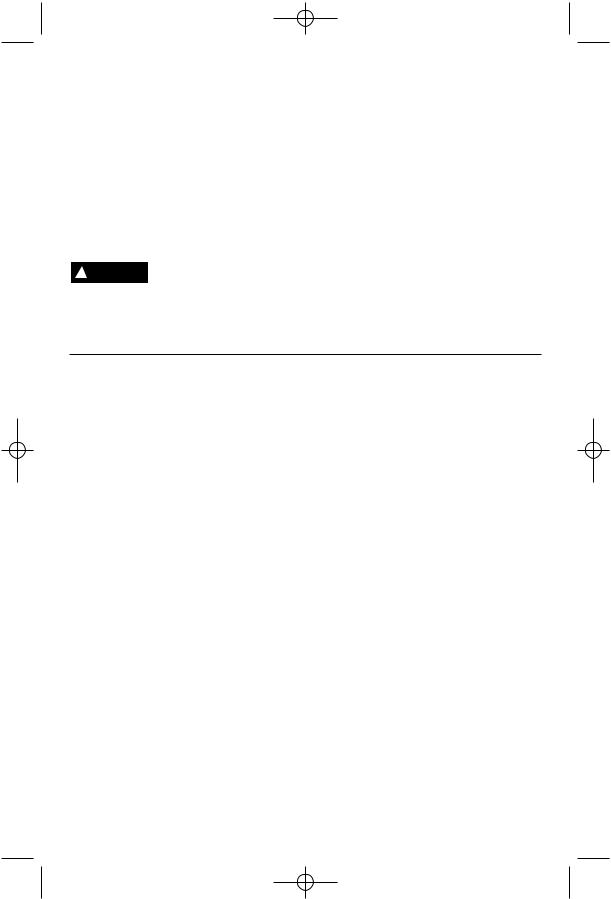
BM 2610914527 3/03 3/18/03 10:47 AM Page 5
Blade depth and bevel adjusting locking knobs must be tight and secure before making cut. If blade adjustment shifts while cutting, it may cause binding and KICKBACK.
Using the saw with an excessive depth of cut setting increases loading on the unit and susceptibility to twisting of the blade in the kerf. It also increases the surface area of the blade available for pinching under conditions of kerf close down.
Use extra caution when making a “Pocket Cut” into existing walls or other blind areas.
The protruding blade may cut objects that can cause KICKBACK.
Some dust created by power sanding, sawing, grinding, drilling, and other construction
activities contains chemicals known to cause cancer, birth defects or other reproductive harm. Some examples of
these chemicals are:
•Lead from lead-based paints,
•Crystalline silica from bricks and cement and other masonry products, and
•Arsenic and chromium from chemicallytreated lumber.
Your risk from these exposures varies, depending on how often you do this type of work. To reduce your exposure to these chemicals: work in a well ventilated area, and work with approved safety equipment, such as those dust masks that are specially designed to filter out microscopic particles.
This product is intended to cut wood and wood-like products only. Dust build up around the lower guard and hub from other materials (plastic, masonry or metal) may disable the lower guard operation.
Battery/Charger
Before using battery charger, read all instructions and cautionary markings on
(1) battery charger, (2) battery pack, and
(3) product using battery.
Use only the charger which accompanied your product or direct replacement as listed in the catalog or this manual. Do not substitute any other charger. Use only Bosch approved chargers with your product. See Functional Description and Specifications.
Do not disassemble charger or operate the charger if it has received a sharp blow, been dropped or otherwise damaged in any way. Replace damaged cord or plugs immediately. Incorrect reassembly or damage may result in electric shock or fire.
Do not recharge battery in damp or wet environment. Do not expose charger to rain or snow. If battery case is cracked or otherwise damaged, do not insert into charger. Battery short or fire may result.
Charge only Bosch approved rechargeable batteries. See Functional Description and Specifications. Other types of batteries may burst causing personal injury and damage.
Charge battery pack in temperatures above +40 degrees F (4 degrees C) and below +105 degrees F (41 degrees C). Store tool and battery pack in locations where temperatures do not go below 40
degrees F (4 degrees C) or will no exceed 120 degrees F (49 degrees C). Allow battery pack to return to room temperature before attempting to charge.This is important to prevent serious damage to the battery cells.
Battery leakage may occur under extreme usage or temperature conditions. Avoid contact with skin and eyes. The battery liquid is caustic and could cause chemical burns to tissues. If liquid comes in contact with skin, wash quickly with soap and water, then with lemon juice or vinegar. If the liquid contacts your eyes, flush them with water for a minimum of 10 minutes and seek medical attention.
Place charger on flat non-flammable surfaces and away from flammable materials when re-charging battery pack.
The charger and battery pack heat during charging. Carpeting and other heat insulating surfaces block proper air circulation which may cause overheating of the charger and battery pack. If smoke or melting of the case are observed unplug the charger immediately and do not use the battery pack or charger.
Use of an attachment not recommended or sold by Bosch may result in a risk of fire, electric shock or injury to persons.
-5-
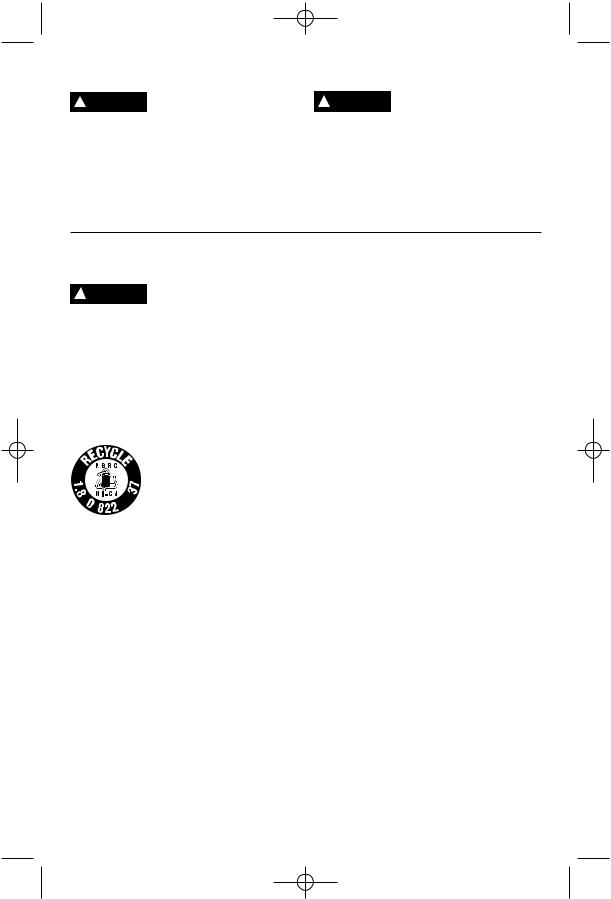
BM 2610914527 3/03 3/18/03 10:47 AM Page 6
Battery Care
When batteries are not in tool or charger, keep them away from metal objects. For example, to
protect terminals from shorting DO NOT place batteries in a tool box or pocket with nails, screws, keys, etc. Fire or injury may result.
To prevent fire or injury ! WARNING when batteries are not in
tool or charger, always place protective cap onto end of battery pack. Protective cap, guards against terminal shorting.
DO NOT PUT BATTERIES INTO FIRE OR EXPOSE TO HIGH HEAT. They may explode.
Battery Disposal
Do not attempt to disassemble the battery or remove any component projecting from
the battery terminals. Fire or injury may result. Prior to disposal, protect exposed terminals with heavy insulating tape to prevent shorting.
NICKEL-CADMIUM BATTERIES
If equipped with a nickel-cadmium battery, the battery must be collected, recycled or disposed of in an environmentally sound manner.
“The EPA certified RBRC Battery Recycling Seal on the nickel-cadmium (Ni-Cd)
battery indicates Robert

 Bosch Tool Corporation is
Bosch Tool Corporation is 
 voluntarily participating in an industry program to collect and recycle
voluntarily participating in an industry program to collect and recycle
these batteries at the end of their useful life,
when taken out of service in the United States or Canada. The RBRC program provides a convenient alterative to placing used Ni-Cd batteries into the trash or the municipal waste stream, which may be illegal in your area.
Please call 1-800-8-BATTERY for information on Ni-Cd battery recycling and disposal bans/restrictions in your area, or return your batteries to a Skil/Bosch/Dremel Service Center for recycling. Robert Bosch Tool Corporation’s involvement in this program is part of our commitment to preserving our environment and conserving our natural resources.”
NICKEL-METAL HYDRIDE BATTERIES
If equipped with a nickel-metal hydride battery, the battery can be disposed of in a municipal solid waste stream.
-6-
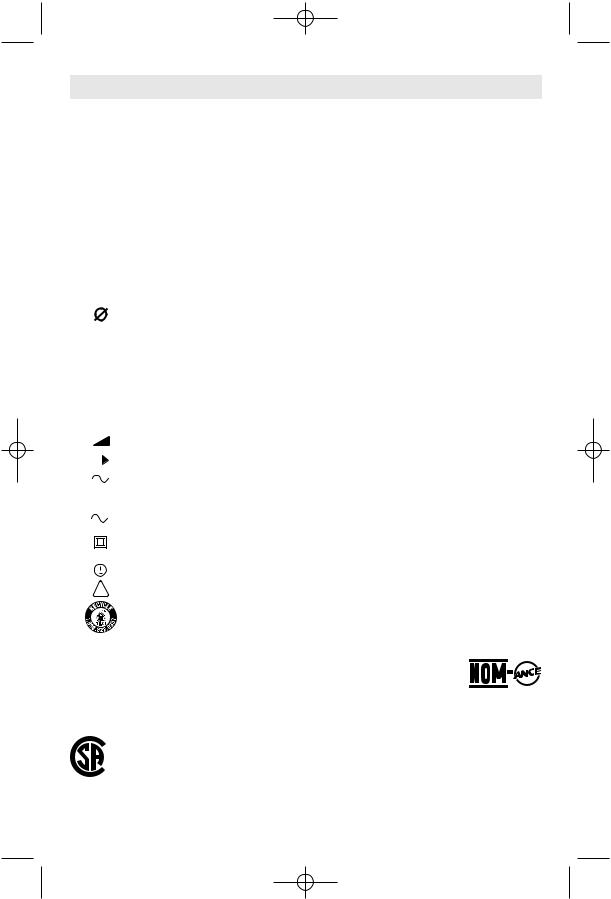
BM 2610914527 3/03 3/18/03 10:47 AM Page 7
Symbols
IMPORTANT: Some of the following symbols may be used on your tool. Please study them and learn their meaning. Proper interpretation of these symbols will allow you to operate the tool better and safer.
Symbol |
Name |
Designation/Explanation |
||||||||
|
|
|
|
|
|
|
|
|
|
|
|
|
|
|
V |
Volts |
Voltage (potential) |
||||
|
|
|
|
A |
Amperes |
Current |
||||
|
|
|
|
|
|
|
|
|
|
|
|
|
Hz |
Hertz |
Frequency (cycles per second) |
||||||
|
|
|
W |
Watt |
Power |
|||||
|
|
kg |
Kilograms |
Weight |
||||||
|
|
|
|
|
|
|
|
|
|
|
|
min |
Minutes |
Time |
|||||||
|
|
|
|
s |
Seconds |
Time |
||||
|
|
|
|
|
|
|
|
|
|
|
|
|
|
|
|
|
|
|
|
Diameter |
Size of drill bits, grinding wheels, etc. |
|
|
|
|
|
|
|
|
|
|
|
|
|
|
n0 |
No load speed |
Rotational speed, at no load |
|||||
.../min |
Revolutions or reciprocation per minute |
Revolutions, strokes, surface speed, |
||||||||
|
|
|
|
|
|
|
|
|
|
orbits etc. per minute |
0 |
|
|
|
Off position |
Zero speed, zero torque... |
|||||
|
|
|
|
|
|
|
|
|
|
|
1, 2, 3, ... |
Selector settings |
Speed, torque or position settings. |
||||||||
I, II, III, |
|
Higher number means greater speed |
||||||||
|
|
|
|
|
|
|
|
|
|
|
0 |
|
|
|
|
|
|
Infinitely variable selector with off |
Speed is increasing from 0 setting |
||
|
|
|
|
|
|
|
|
|
Arrow |
Action in the direction of arrow |
|
|
|
|
|
|
|
|
|
||
|
|
|
|
|
|
|
|
|
Alternating current |
Type or a characteristic of current |
|
|
|
|
|
|
|
|
|
|
|
|
|
|
|
|
|
|
|
|
Direct current |
Type or a characteristic of current |
|
|
|
|
|
|
|
|
|
||
|
|
|
|
|
|
|
|
|
Alternating or direct current |
Type or a characteristic of current |
|
|
|
|
|
|
|
|
|
||
|
|
|
|
|
|
|
|
|
|
|
|
|
|
|
|
|
|
|
|
Class II construction |
Designates Double Insulated |
|
|
|
|
|
|
|
|
|
||
|
|
|
|
|
|
|
|
|
|
Construction tools. |
|
|
|
|
|
|
|
|
|
|
|
|
|
|
|
|
|
|
|
|
|
|
|
|
|
|
|
|
|
|
|
Earthing terminal |
Grounding terminal |
|
|
|
|
|
|
|
|
|
||
|
|
|
|
|
|
|
|
|
Warning symbol |
Alerts user to warning messages |
|
|
|
|
|
|
|
|
|
||
|
|
|
|
|
|
|
|
|
||
|
|
|
|
|
|
|
|
|
Ni-Cad RBRC seal |
Designates Ni-Cad battery recycling |
|
|
|
|
|
|
|
|
|
|
program |
|
|
|
|
|
|
|
|
|
|
|
This symbol designates that this tool is listed by Underwriters Laboratories.
This symbol designates that this tool is listed by the Canadian Standards Association.
This symbol designates that this tool is listed to Canadian Standards by Underwriters Laboratories.
This symbol designates that this tool is listed by Underwriters Laboratories, and listed to Canadian Standards by Underwriters Laboratories.
This symbol designates that
this tool complies to NOM Mexican Standards.
-7-
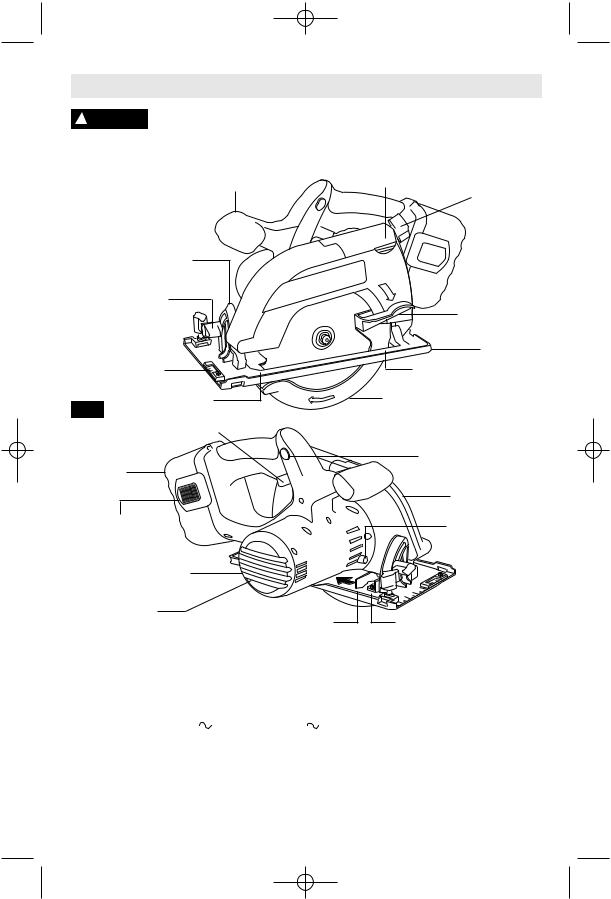
BM 2610914527 3/03 3/18/03 10:47 AM Page 8
Functional Description and Specifications
Disconnect battery pack from tool or place the switch in the locked or ! WARNING off position before making any assembly, adjustments or changing
accessories. Such preventive safety measures reduce the risk of starting the tool accidentally.
AUXILIARY
HANDLE
Cordless
Circular Saws
CALIBRATED BEVEL
QUADRANT
BEVEL
ADJUSTMENT
KNOB
ADJUSTABLE
LINE GUIDE
|
BEGINNING OF |
FIG. 1 |
CUT ARROW |
|
TRIGGER |
BATTERY |
|
PACK |
|
BATTERY PACK
RELEASE TABS
BLADE WRENCH &
STORAGE AREA
DUST PORT
COVER DEPTH ADJUSTMENT
KNOB
LOWER
GUARD LIFT
LEVER
FOOT
END OF CUT ARROW
LOWER GUARD
SAFETY SWITCH
RELEASE
BUTTON
UPPER GUARD
LOCK
BUTTON
VENTILATION
OPENINGS PUSH 45°STOP SPRING IN DIRECTION OF ARROW
FOR 50°
ALIGNMENT |
SCREW |
Tool |
|
|
|
|
|
|
|
|
Maximum Capacities |
|
Model number |
1660 |
|
|
1662 |
|
|
|
|
Blade |
6-1/2" |
Voltage rating |
24 V |
|
|
18 V |
|
|
|
|
Depth of cut at 90° |
2-1/8" |
|
|
|
|
|
||||||
No load speed |
n0 3,600/min |
n0 3,600/min |
Depth of cut at 45° |
1-5/8" |
||||||
Charge time |
1 hr |
|
|
1 hr |
|
|
|
Depth of cut at 50° |
1-1/2" |
|
Charger |
BC004, 6, & BC016 |
BC003, 4, 6, & BC016 |
ATTENTION: Use only thin |
|||||||
Voltage rating |
120 V |
|
60 Hz |
120 V |
|
|
60 Hz |
kerf blades designed for |
||
Battery pack |
BAT030 & BAT031 |
BAT025 & BAT026 |
Cordless Circular Saws. |
|||||||
BC006 charger requires 12 V DC input
NOTE: ONLY USE CHARGERS LISTED ABOVE
For replacement blades we recommend Bosch Cordless Circular saw blades. Their thin kerf and tooth design deliver the best speed, quality of cut, and reduce battery drain. Use of standard blades will substantially affect the performance and reduce run-time.
-8-
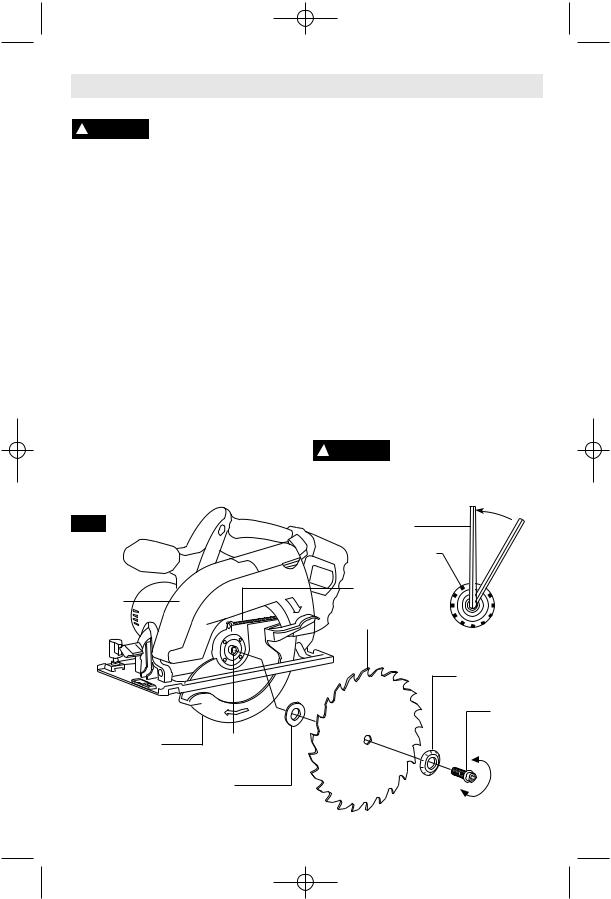
BM 2610914527 3/03 3/18/03 10:47 AM Page 9
Assembly
ATTACHING THE BLADE |
Do not use wrenches with longer handles, |
||
Disconnect battery pack |
since it may lead to over tightening of the |
||
! WARNING from tool or place the |
blade stud. |
||
switch in the locked or off position before |
VARI-TORQUE CLUTCH |
||
making any assembly, adjustments or |
|||
This clutching action is provided by the friction |
|||
changing accessories. Such preventive |
|||
of the OUTER WASHER against the BLADE |
|||
safety measures reduce the risk of starting |
|||
and permits the blade shaft to turn when the |
|||
the tool accidentally. |
|
||
|
blade encounters excessive resistance. When |
||
1. Turn BLADE STUD with wrench provided |
|||
the BLADE STUD is properly tightened (as |
|||
clockwise and remove BLADE STUD and |
described in No. 5 of Attaching The Blade), the |
||
OUTER WASHER (Fig. 2). If the shaft moves |
blade will slip when it encounters excessive |
||
while attempting to loosen the blade stud |
|||
resistance, thus reducing saw’s tendency to |
|||
press the lock button (Fig. 1). |
|
||
|
KICKBACK. |
||
2. Retract the lower guard all the way up into |
|||
One setting may not be sufficient for cutting all |
|||
the upper guard. While retracting the lower |
|||
materials. If excessive blade slippage occurs, |
|||
guard, check operation and condition of the |
|||
tighten the blade stud 1/2 mark more. |
|||
LOWER GUARD SPRING. |
|
||
|
OVERTIGHTENING THE BLADE STUD |
||
3. Make sure the saw teeth and arrow on the |
|||
NULLIFIES THE EFFECTIVE-NESS OF THE |
|||
blade point in the same direction as the arrow |
CLUTCH. |
||
on the lower guard. |
|
DUST EXTRACTION |
|
4. Slide blade through slot in the foot and |
|||
Your tool is equipped is with a dust port for |
|||
mount it against the INNER WASHER on the |
|||
dust and chip extraction. To use this feature, |
|||
shaft. Be sure the large diameter of the OUTER |
|||
open dust port cover and attach vacuum hose |
|||
washer lays flush against the blade. |
|||
(optional accessory) to the dust port, and |
|||
5. Reinstall OUTER WASHER and tighten |
|||
connect opposite end the hose to a shop |
|||
BLADE STUD finger tight. The face of outer |
|||
vacuum cleaner. |
|||
washer has marks around it that will help you |
|||
To prevent personal injury, |
|||
properly adjust the blade stud. Press lock |
|||
button to lock shaft and TIGHTEN BLADE |
! WARNING always position vacuum |
||
STUD COUNTER-CLOCKWISE ONE MARK |
hose so that it does not interfere with the |
||
ON BLADE WASHER WITH THE WRENCH |
lower guard, or the cutting operation at all |
||
PROVIDED. |
|
settings. |
|
FIG. 2 |
|
WRENCH |
|
|
|
MARK |
|
|
|
LOWER |
|
UPPER |
|
GUARD |
|
|
SPRING |
||
GUARD |
|
||
|
|
||
|
|
BLADE |
|
|
|
OUTER WASHER |
|
|
|
OUTER WASHER |
|
|
|
Large Diameter |
|
|
|
Faces Blade |
|
|
|
BLADE |
|
|
|
STUD |
|
LOWER |
BLADE |
TIGHTEN |
|
GUARD |
SHAFT |
||
|
|||
INNER WASHER
Large Diameter
Faces Blade
LOOSEN
-9-
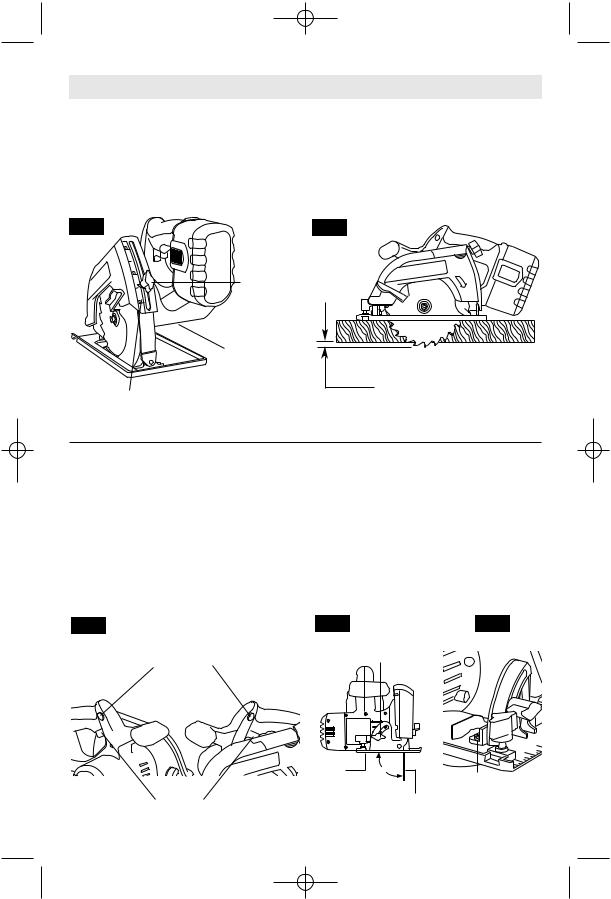
BM 2610914527 3/03 3/18/03 10:47 AM Page 10
Operating Instructions
DEPTH ADJUSTMENT
Disconnect battery pack from tool. Loosen the depth adjustment knob located on the back side of the upper guard. Hold the foot down with one hand and raise or lower saw by the handle. Tighten knob at the depth
setting desired. Check desired depth (Fig. 3).
Not more than one tooth length of the blade should extend below the material to be cut, for minimum splintering (Fig. 4).
FIG. 3
2
1
0
CALIBRATED DEPTH
BRACKET
DEPTH
ADJUSTMENT
KNOB
BLADE WRENCH
&STORAGE AREA
FIG. 4
ONE TOOTH LENGTH SHOULD PENETRATE WOOD FOR MINIMUM SPLINTERING
SAFETY SWITCH
The safety switch is designed to prevent accidental starts. To operate safety switch, press the release button with your thumb on either side of handle to disengage the lock, then pull the trigger (Fig. 5). When the trigger is released the button will engage the safety switch automatically, and the trigger will no longer operate. (See Switch & General Cuts on page 11.)
FIG. 5
SAFETY SWITCH
RELEASE
BUTTON
90° CUTTING ANGLE CHECK
Disconnect battery pack from tool. Set foot to maximum depth of cut setting. Loosen bevel adjustment knob, set to 0° on quadrant, retighten knob and check for 90° angle between the blade and bottom plane of foot with a square (Fig. 6). Make adjustments by turning the small alignment screw, if necessary (Fig. 7).
FIG. 6 |
FIG. 7 |
BEVEL
ADJUSTMENT
KNOB
FOOT 90°
ALIGNMENT
SCREW
TRIGGER |
BLADE |
-10-

BM 2610914527 3/03 3/18/03 10:47 AM Page 11
BEVEL ADJUSTMENT
Disconnect battery pack from tool. The foot can be adjusted up to 45° by loosening the bevel adjustment knob at the front of the saw. Align to desired angle on calibrated quadrant. Then tighten bevel adjustment knob (Fig. 8). For 50° loosen bevel adjustment knob, depress 45° stop spring (Fig. 9), align foot to 50 mark on quadrant and tighten knob. Because of the increased amount of blade engagement in the work and decreased stability of the foot, blade binding may occur. Keep the saw steady and the foot firmly on the workpiece.
FIG. 8
QUADRANT
BEVEL
ADJUSTMENT
KNOB
ADJUSTABLE LINE GUIDE
For a straight 90° cut you can use the left or right side of notch in the foot. For 45° bevel cuts, use the right side (Fig 9). The guide can be adjusted to allow for variation in blade thicknesses for whichever side of the blade the user would prefer to cut the line on.
TO ATTACH: Disconnect battery pack from tool. Align hole in adjustable line guide with hole in foot and secure with screw provide.
TO ADJUST: Loosen but don’t remove, the adjustment screw enough so the guide can move freely. Set a straightedge flat on the preferred side of the blade, lining up both the edge of the straightedge and the edge of the guide where the 0° mark is located.
90° |
45° |
|
VERTICAL |
BEVEL CUTS |
|
CUTS |
ADJUSTABLE LINE |
|
|
||
GUIDE |
GUIDE |
|
ADJUSTMENT |
PUSH 45°STOP |
|
SCREW |
||
SPRING IN |
||
|
||
|
DIRECTION OF |
|
FIG. 9 |
ARROW FOR 50° |
|
45°STOP |
||
|
||
|
SPRING |
|
|
0º 45º |
SWITCH
To turn tool “ON”, squeeze the trigger switch. To turn the tool “OFF”, release the trigger switch, which is spring loaded and will return to the off position automatically.
Your saw should be running at full speed BEFORE starting the cut, and turned off only AFTER completing the cut. To increase switch life, do not turn switch on and off while cutting.
BRAKE
When the trigger is released it activates the electrical brake to stop the blade quickly. This feature is especially useful when making repetitive cuts.
GENERAL CUTS
Always hold the saw handle with one hand and the auxiliary handle or housing with the other.
Always make sure saw foot rests on portion of work surface that does not drop off.
Always be sure either hand ! WARNING does not interfere
with the free movement of the lower guard.
Maintain a firm grip and operate the switch with a decisive action. Never force the saw. Use light and continuous pressure.
After completing a cut and the trigger has been released, be aware of the necessary time it
takes for the blade to come to a complete stop during coast down. Do not allow the saw to brush against your leg or side, since the lower guard is retractable, it could catch on your clothing and expose the blade. Be aware of the necessary blade exposures that exist in both the upper and lower guard areas.
When cutting is interrupted, to resume cutting: squeeze the trigger and allow the blade to reach full speed, re-enter the cut slowly and resume cutting.
When cutting across the grain, the fibers of the wood have a tendency to tear and lift. Advancing the saw slowly minimizes this effect. For a finished cut, a cross cut blade or miter blade is recommended.
-11-
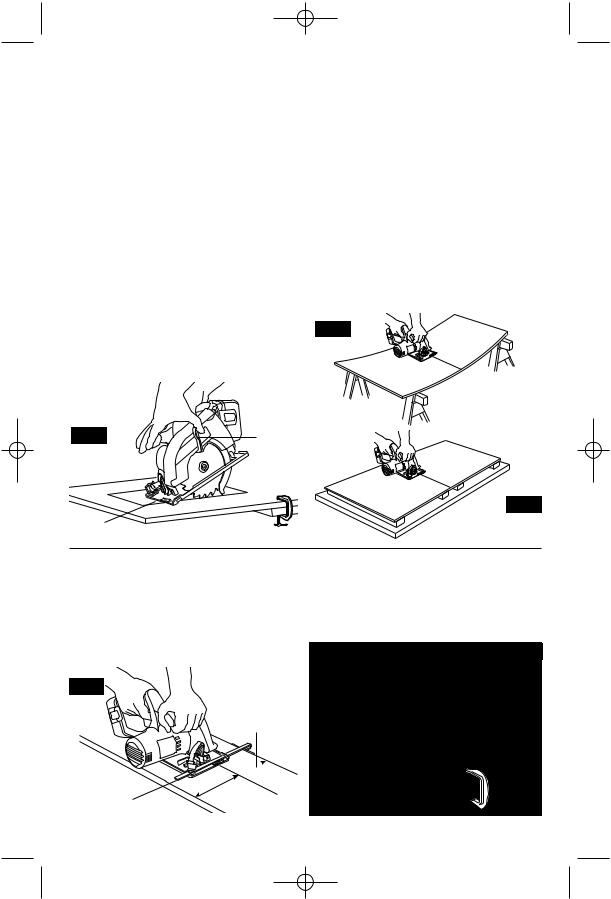
BM 2610914527 3/03 3/18/03 10:47 AM Page 12
POCKET CUTS
Disconnect battery pack from tool before making adjustments. Set depth adjust-ment according to material to be cut. Tilt saw forward with cutting guide notch lined up with the line you’ve drawn. Raise the lower guard, using lift lever and hold the saw by the front and rear handles (Fig. 10).
With the blade just clearing the material to be cut, start the motor. Gradually lower the back end of saw using the front end of the foot as the hinge point. WARNING: As blade starts cutting the material, release the lower guard immediately. When the foot rests flat on the surface being cut, proceed cutting in forward direction to end of cut. WARNING: Allow blade to come to a complete stop before lifting the saw from cut. Also, never pull the saw backward since blade will climb out of the material and KICKBACK will occur. Turn saw around and finish the cut in the normal manner, sawing forward. If corners of your pocket cut are not completely cut through, use a jigsaw or hand saw to finish the corners.
CUTTING LARGE SHEETS
Large sheets and long boards sag or bend, depending on support. If you attempt to cut without leveling and properly supporting the piece, the blade will tend to bind, causing KICKBACK and extra load on the motor (Fig. 11).
Support the panel or board close to the cut, as shown in (Fig. 12). Be sure to set the depth of the cut so that you cut through the sheet or board only and not the table or work bench. The two-by-fours used to raise and support the work should be positioned so that the broadest sides support the work and rest on the table or bench. Do not support the work with the narrow sides as this is an unsteady arrangement. If the sheet or board to be cut is too large for a table or work bench, use the supporting two-by-fours on the floor and secure.
FIG. 11
WRONG
LOWER
FIG. 10 GUARD
LIFT
LEVER
FIG. 12
FOOT |
RIGHT |
RIP CUTS
The combination blade provided with your saw is for both cross cuts and rip cuts. Ripping is cutting lengthwise with the grain of the wood. Rip cuts are easy to do with a rip fence (Fig. 13). To attach fence, insert fence through slots in foot to desired width as shown and secure with the knob.
FIG. 13
DESIRED
WIDTH
OF CUT
RIP BOARD GUIDE
When rip cutting large sheets, the rip fence may not allow the desired width of cut. Clamp or nail a straight piece of 1" (25 mm) lumber to the sheet as a guide (Fig. 14). Use the right side of the foot against the board guide.
FIG. 14
DESIRED
LINE
OF CUT
RIP
KNOB 
 BOARD GUIDE
BOARD GUIDE
RIP
FENCE
-12-
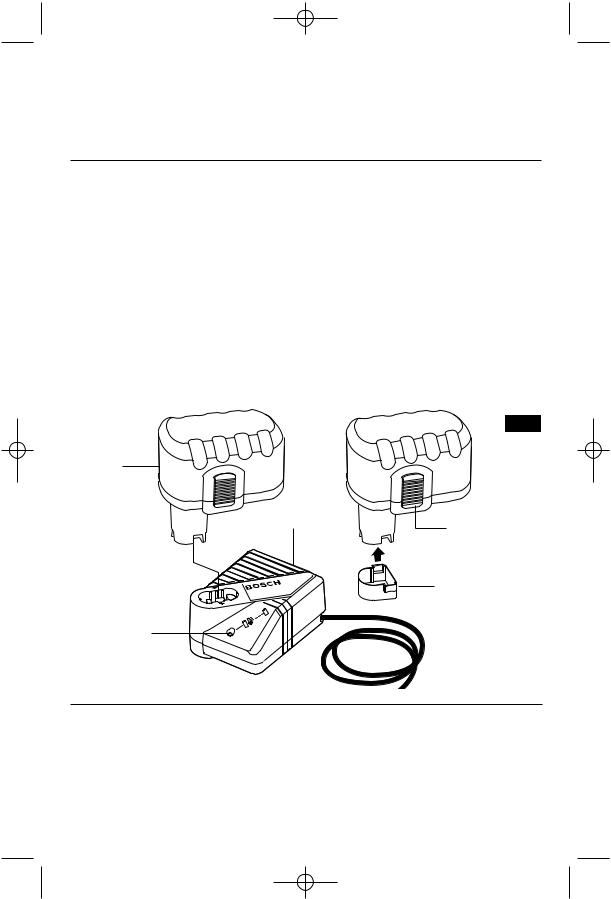
BM 2610914527 3/03 3/18/03 10:47 AM Page 13
RELEASING AND INSERTING BATTERY PACK
Release battery pack from tool by pressing on both sides of the battery release tabs and pull downwards. Before inserting battery pack, remove protective cap from battery
pack. To insert battery, align battery and slide battery pack into tool until it locks into position. Do not force.
CHARGING BATTERY PACK (1 HOUR CHARGER)
Plug charger cord into your standard power outlet. Before inserting battery pack, remove protective cap, then insert battery pack into charger (Fig. 15).
The charger’s green indicator will begin to “BLINK”. This indicates that the battery is receiving a fast charge. Fast-charging will automatically stop when the battery pack is fully charged.
When the indicator light stops “BLINKING” (and becomes a steady green light) fast charging is complete.
When you begin the charging process of the battery pack, a steady green light could also mean the battery pack is too hot or too cold.
The purpose of the light is to indicate that the battery pack is fast-charging. It does not indicate the exact point of full charge. The light will stop blinking in less time if the battery pack was not completely discharged.
When the battery pack is fully charged, unplug the charger (unless you're charging another battery pack) and slip the battery pack back into the tool handle (Fig.15).
To prevent fire or injury when batteries are not in tool or charger, always place protective cap onto end of battery pack.
FIG. 15
BATTERY
PACK
CHARGER |
BATTERY PACK |
|
RELEASE TABS |
PROTECTIVE
CAP
INDICATOR
LIGHT
IMPORTANT CHARGING NOTES
1. The battery pack accepts only about 80% of its maximum capacity with its first few charge cycles. However, after the first few charge cycles, the battery will charge to full capacity.
2. The charger was designed to fast charge the battery only when the battery temperature is between 40˚F (4˚C) and 105˚F (41˚C).
-13-
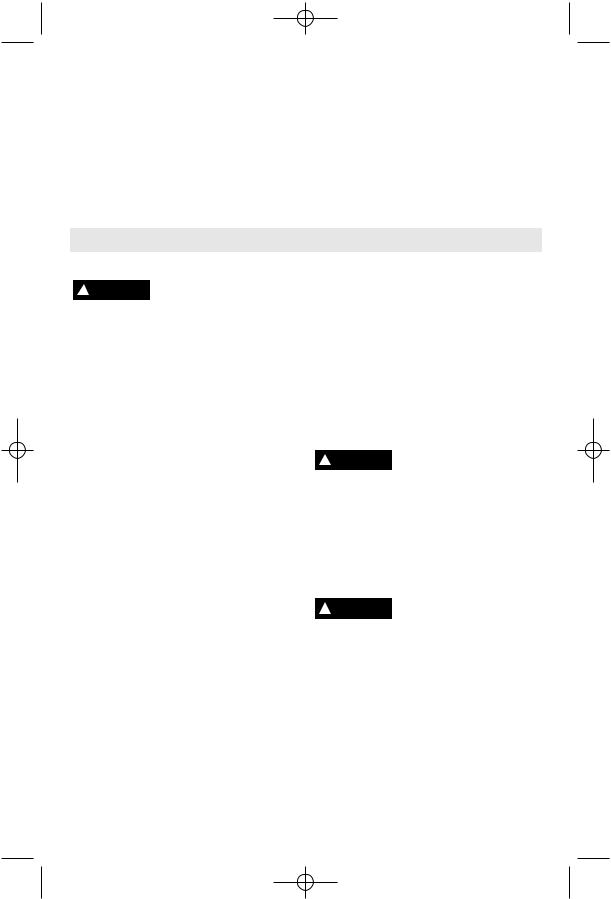
BM 2610914527 3/03 3/18/03 10:47 AM Page 14
3.A substantial drop in operating time per charge may mean that the battery pack is nearing the end of its life and should be replaced.
4.If you anticipate long periods (i.e. a month or more) of non-use of your tool, it is best to run your tool down until it is fully discharged before storing your battery pack. After a long
period of storage, the capacity at first recharge will be lower. Normal capacity will be restored in two or three charge/discharge cycles. Remember to unplug charger during storage period.
5.If battery does not charge properly:
a. Check for voltage at outlet by plugging in some other electrical device.
Maintenance
Service
NO USER SERVICEABLE
PARTS INSIDE. Preventive maintenance performed by unauthorized personnel may result in misplacing of internal wires and components which could cause serious hazard. We recommend that all tool service be performed by a Bosch Factory Service Center or Authorized Bosch Service Station. SERVICEMEN: Disconnect tool and/or charger from power source before servicing.
BATTERIES
Be alert for battery packs that are nearing their end of life. Battery packs typically last from 500 to 1000 charges. If you notice decreased tool performance or significantly shorter running time between charges then it is time to replace the battery pack. Failure to do so can cause the tool to operate improperly or damage the charger.
Long term battery storage should be in the discharged state. Battery packs last longer and re-charge better when they are stored discharged. Remember to fully recharge battery packs before using after prolonged storage.
TOOL LUBRICATION
Your Bosch tool has been properly lubricated and is ready for use.
D.C. MOTORS
The motor in your tool has been engineered for many hours of dependable service. To maintain peak efficiency of the motor, we recommend it be examined every six months. Only a genuine Bosch replacement motor specially designed for your tool should be used.
BEARINGS
Bearings which become noisy (due to heavy load or very abrasive material cutting) should be replaced at once to avoid overheating and motor failure.
Cleaning
To avoid accidents, always disconnect the tool and/or charger from the power supply before
cleaning. The tool may be cleaned most effectively with compressed dry air. Always wear safety goggles when cleaning tools with compressed air.
Ventilation openings and switch levers must be kept clean and free of foreign matter. Do not attempt to clean by inserting pointed objects through opening.
Certain cleaning agents and ! CAUTION solvents damage plastic
parts. Some of these are: gasoline, carbon tetrachloride, chlorinated cleaning solvents, ammonia and household detergents that contain ammonia.
-14-
